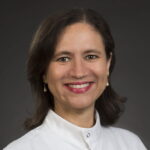Circadian rhythms are physical, mental, and behavioral changes that follow a 24-hour cycle. These natural processes respond primarily to light and dark and affect most living things, including animals, plants, and microbes. Biological clocks are organisms’ natural timing devices, regulating the cycle of circadian rhythms.
The daily light-dark cycle governs rhythmic changes in the behavior and/or physiology of most species. Studies have found that these changes are governed by a biological clock, which in mammals is located in two brain areas called the suprachiasmatic nuclei. (Vitaterna et al, 2001)
Like what you’re learning? Download a brochure for our Orofacial Pain and Oral Medicine certificate or master’s degree program.
Suprachiasmatic Nucleus
In mammals, the circadian system is organized hierarchically such that the suprachiasmatic nucleus (SCN) is the main circadian clock that receives light information from the eye and entrains it to the light-dark cycle. The SCN then coordinates the timing of tissue clocks so internal rhythms are aligned with environmental cycles. In the central suprachiasmatic nucleus (SCN) of the hypothalamus, a coupled population of neuronal circadian oscillators acts as a master pacemaker for the organism to drive rhythms in activity and rest, feeding, body temperature, and hormones. (Mohawk et al, 2012)
Circadian Cycle and Pain
Chronobiological rhythms, which include the 24-hr circadian cycle, have recently been shown to regulate both nervous and immune cell activity and function. While the most prominent cell type to display circadian rhythms are central neurons in the SCN, circadian rhythms have also been found to modulate the activity and function of peripheral and central neurons of the pain pathway. (Segal et al, 2017)
Circadian rhythms of pain are a complex result of the distributed rhythms present throughout the pain system, especially those of the descending pain modulatory system, and the rhythms of the systems with which it interacts, including the opioid, endocrine, and immune systems. (Bumgarner et al, 2021)
Several primary headaches demonstrate either a circadian/circannual rhythmicity in attack onset or are directly associated with sleep itself. Migraine and cluster headaches both show distinct attack patterns. While the underlying mechanisms of this circadian variation in attack onset remain to be fully explored, recent evidence points to clear physiological, anatomical, and genetic points of convergence. The hypothalamus has emerged as a key brain area in several headache disorders including migraine and cluster headache. (Holland et al, 2018)
Cluster headache is an intermittent pain disorder with an exceedingly precise circadian timing, and preliminary evidence is emerging linking several circadian components. (Burish et al, 2018)
Earn an Online Postgraduate Degree in Orofacial Pain and Oral Medicine
Are you interested in a variety of issues focused on orofacial pain, medicine and sleep disorders? Consider enrolling in the Herman Ostrow School of Dentistry of USC’s online, competency-based certificate or master’s program in Orofacial Pain and Oral Medicine.
References
- Vitaterna MH, Takahashi JS, Turek FW. Overview of circadian rhythms. Alcohol Res Health. 2001;25(2):85-93. PMID: 11584554; PMCID: PMC6707128.
- Mohawk JA, Green CB, Takahashi JS. Central and peripheral circadian clocks in mammals. Annu Rev Neurosci. 2012;35:445-62. doi: 10.1146/annurev-neuro-060909-153128. Epub 2012 Apr 5. PMID: 22483041; PMCID: PMC3710582.
- Segal JP, Tresidder KA, Bhatt C, Gilron I, Ghasemlou N. Circadian control of pain and neuroinflammation. J Neurosci Res. 2018 Jun;96(6):1002-1020. doi: 10.1002/jnr.24150. Epub 2017 Sep 2. PMID: 28865126.
- Bumgarner JR, Walker WH 2nd, Nelson RJ. Circadian rhythms and pain. Neurosci Biobehav Rev. 2021 Oct;129:296-306. doi: 10.1016/j.neubiorev.2021.08.004. Epub 2021 Aug 8. PMID: 34375675; PMCID: PMC8429267.
- Holland PR, Barloese M, Fahrenkrug J. PACAP in hypothalamic regulation of sleep and circadian rhythm: importance for headache. J Headache Pain. 2018 Mar 5;19(1):20. doi: 10.1186/s10194-018-0844-4. PMID: 29508090; PMCID: PMC5838029.
- Burish MJ, Chen Z, Yoo SH. Emerging relevance of circadian rhythms in headaches and neuropathic pain. Acta Physiol (Oxf). 2019 Jan;225(1):e13161. doi: 10.1111/apha.13161. Epub 2018 Jul 25. PMID: 29969187; PMCID: PMC6381824.

